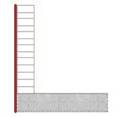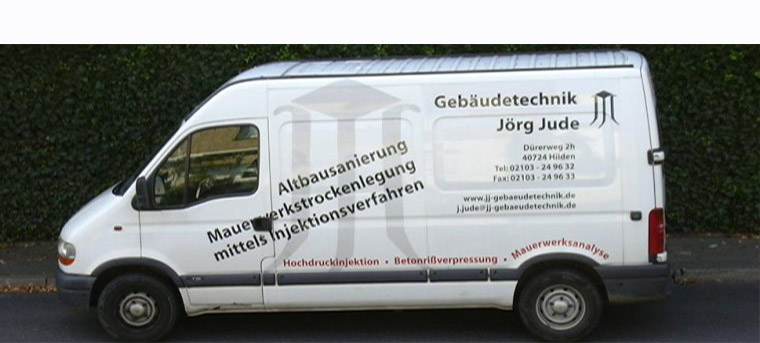Jörg Jude Gebäudetechnik
Our Service :
Subsequent horizontal blocking
 Pressure injections are especially applied to severely thoroughly damp or capillary saturated masonry, because even poricidal spaces can be filled up with injection material which are capillarily not accessible. To this the drilling holes are drilled with a distance of 10 to 12cm and a diameter of 14 to 25mm. read more...
Pressure injections are especially applied to severely thoroughly damp or capillary saturated masonry, because even poricidal spaces can be filled up with injection material which are capillarily not accessible. To this the drilling holes are drilled with a distance of 10 to 12cm and a diameter of 14 to 25mm. read more...
Veiled injection / gelatination
 For the subsequent outer sealing the structure is completely bored through.
The injected gel at the same time swells after having contact with the existing water inside the soil and works as a surface sealing depending on how evenly it could spread over the exterior wall surface. For the gelatination the level of sealing is formed in the component which means that the injection substance in the construction material structure is placed in such a manner that a continuous level of sealing develops. read more...
For the subsequent outer sealing the structure is completely bored through.
The injected gel at the same time swells after having contact with the existing water inside the soil and works as a surface sealing depending on how evenly it could spread over the exterior wall surface. For the gelatination the level of sealing is formed in the component which means that the injection substance in the construction material structure is placed in such a manner that a continuous level of sealing develops. read more...
Concrete crack compaction
 n push or pull stressed components out of ferroconcrete cracks develop that can have negative impacts on the durability and the performance characteristics.
From certain width of flaws the durability of the building component is not guaranteed any longer because water and oxygen as well as other harmful substances like salts can get through the flaw to the reinforcement and evoke a corrosion of the steel.read more...
n push or pull stressed components out of ferroconcrete cracks develop that can have negative impacts on the durability and the performance characteristics.
From certain width of flaws the durability of the building component is not guaranteed any longer because water and oxygen as well as other harmful substances like salts can get through the flaw to the reinforcement and evoke a corrosion of the steel.read more...
Thermal and convective drying of wet basements
 Masonry often has an increased moisture content caused by ascending water or constructional damages. For the preparation of redevelopment measures or for a near-term usage the masonry is supposed to be dried quickly.
With common used procedures like constructional dryers there is the problem of the disposal of evaporated water from deeper layers of earth especially with thick masonry in wet basements. read more...
Masonry often has an increased moisture content caused by ascending water or constructional damages. For the preparation of redevelopment measures or for a near-term usage the masonry is supposed to be dried quickly.
With common used procedures like constructional dryers there is the problem of the disposal of evaporated water from deeper layers of earth especially with thick masonry in wet basements. read more...
Internal Insulation Humid Walls
Internal insulation with calciumsilicate panels
About 90% of todays residential buildings have been build before 1977, the day when the law of the first heat insulation act came into effect. Excluding the area of the modernisation of windows these houses are predominantly in an energetically insufficient state. read more...
Internal sealing
In case of a subsequent internal sealing there are predominantly mineral resp. flexible thickening muds in connection with an inhibiting plaster resp. refurbishing plaster or calciumsilicate panels that come into operation. Initially the damaged wall coating is layed open until the core masonry. read more...
Construction sealing according to Din 18195

High quality used basements have to be durably protected from moisture coming from the ground. The requirements to the sealing are aligned with the stress by moisture.
The revised version of DIN 18195 – 4 from August 2000 newly classifies the service conditions of stress by moisture. It now differentiates between ground moisture, seepage water, non-building-up of seepage water, temporarily building-up seepage water and pushing water. Additionally it incorporates plastic-modified bitumen-thick-coatings as well as cold self-adhesive sealing sheets.read more...





